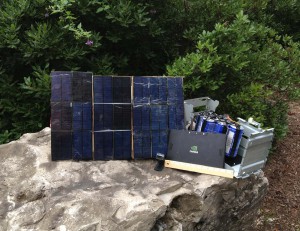No-waste computing
BLOG: Heidelberg Laureate Forum

Your smartphone may not throw away gas as you use it, but be sure that it is a source of greenhouse pollution. “The emissions associated to keep an internet server working are around 3 metric tons of CO2 per year, comparable to those of gasoline burned by car in the same time, 4.75 metric tons”, says Zhenhua Liu, a researcher in IT and sustainability at the California Institute of Technology, who points out that the emissions of IT in the US are comparable to those of the airline industry in the country.
Zhenhua is one of four young scientists working in IT sustainability, who took part in the Heidelberg Laureate Forum last week. He is trying to match the irregular supply of energy from light and wind with the power demand of big data centers. He is developing “geographical load balancing” algorithms, that send the traffic to data centers where more renewable generation is available at a certain moment in time. They also delay noncritical workload at a single data center, when little energy is available. Zhenhua’s group is testing those algorithm in collaboration with Google and Akamai, in the west coast of the US, an area were plenty of data centers are located. He has also helped designing the first industrial zero-emissions data center, which is operating at Hewlett Packard in Palo Alto.
“But energy efficiency in IT is not only a matter of cutting greenhouse gases: power issues bound the performance of computers”, says Melanie Kambadur, a researcher at Columbia University, also at the HLF. “In the internet of things, devices are heavily battery constrained”, she points out. Melanie is comparing several different techniques proposed in the literature to improve the efficiency of a server, to understand what are the main lessons contained in those proposals.

“Saving energy is essential for computing in remote villages, like those in the rural areas of my native Irak”, says Amal Fahad, who has put in place a sustainable, sunlight powered computational node (see picture) at the campus of the University of Rochester, where she works. The device uses a solar panel and small size supercapacitors. Amal has also developed the software that allows to use the internet connection only when it is necessary: for example, to download a Google document locally, allowing the local users to modify it, while keeping coherence with modifications made by remote users. She thinks that this device could be useful also in other settings, like tracking animals in the wild, where devices that work self-sustainably for a long time in the middle of nowhere are needed.
Paul Matthew Carpenter, of the Barcelona Supercomputing Center, is working on a different approach to data centers efficiency. The idea is to apply to them the ARM architecture, which now has 95% of the market share in smartphones, because it is optimized for battery-powered devices. This effort is part of the Euroserver project. Carpenter is also researching energy efficiency in supercomputers. He has helped designing and simulating a system, that in the future should allow to turn off the interconnection between the nodes of a supercomputer, when it is not needed (because it consumes a lot of power), while predicting when it will be needed again, and so turning it on in time.
Read more:
From Sustainable IT to IT for Sustainability


nice your maintenance ideas is good and your content is great thanks for sharing this information
Bucky Vest
The blog generates user active content. That is very user friendly and easy to understand.
You always write in favor of positive things and only look the genuine quality. Marvelous concept!
I read your article briefly i think your article is too best !